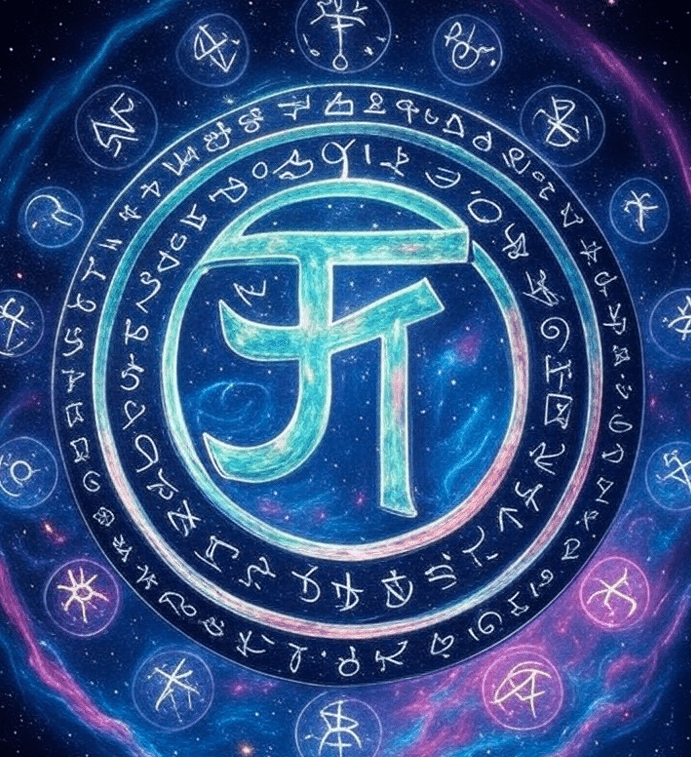Encoding Gravity, Mass, and Space through Adinkras and the Electric Universe Theory
Abstract
In modern physics, the universe is typically described through two major lenses: the geometry of spacetime (general relativity) and the behavior of particles (quantum field theory). Yet beneath both, something stranger lurks — a code-like structure that may underpin physical law itself. This article proposes a unifying model where:
- The Electric Universe (EU) framework functions not just as a physical theory, but as the simulation substrate of reality.
- Adinkra structures represent 1D symbolic code — the pre-geometric logic instructions that define symmetry, interaction, and transformation.
- The emergence of mass, inertia, and gravity occurs not from particles, but from a dimensional translation — where 1D symbolic Adinkras unfold into 2D (and higher) spatial geometry.
- The so-called “dark matter” problem is reframed as the result of referenced, unrendered code being executed by the simulation substrate to preserve internal consistency — without needing physical mass.
- This dimensional boundary, where symbol becomes structure, is termed the Zero Point of Symbolic Reality.
This framework aims to reconcile gravity and electromagnetism, merge simulation theory with plasma physics, and suggest that physical law itself may be a byproduct of higher-dimensional symbolic encoding.
1. Introduction: Beyond Physics, Into Architecture
If the universe is a simulation — a proposition increasingly discussed in both scientific and philosophical circles — we must ask:
- What runs the simulation?
- What is rendered, and what is referenced?
- Why does the universe behave mathematically — and yet feel so organic?
This article proposes a convergence: the Electric Universe theory describes the physical rendering system, while Adinkras represent the underlying symbolic logic. The Zero Point of Symbolic Reality is where the transition occurs between symbolic instruction and observable behavior — where logic becomes gravity, mass, and form.
2. The Electric Universe as Simulation Substrate
The Electric Universe (EU) framework proposes that:
- Space is not empty, but filled with plasma — charged particles responsive to electromagnetic fields.
- Birkeland currents, double layers, and Z-pinches shape cosmic structure, not gravity alone.
- Many galactic phenomena (e.g. rotation curves, solar corona heating) are better explained by electromagnetic tension and feedback, not invisible matter.
But beyond its astrophysical applications, the Electric Universe may also be interpreted as the computational substrate of a simulation — the equivalent of a game engine’s render loop.
Plasma filaments = data buses
Charge differentials = logical tension
EM field interactions = procedural geometry
Birkeland currents = universe-scale logic gates
In this view, the Electric Universe isn’t an alternative to gravity — it’s the simulation layer that produces gravitational effects by compensating for charge-based discrepancies within the field logic.
3. Adinkras: The Code Layer Beneath Geometry
Adinkras, developed in modern physics by Dr. S. James Gates and colleagues, are:
- Graphical representations of 1D supersymmetric algebra.
- Encoded with error-correcting codes found in digital communication systems.
- Capable of mapping boson-fermion relationships via colored edges and node connections.
- Not representations of particles — but of transformations and symmetry relationships.
Adinkras are not visualizations of things. They are blueprints for how things behave — compact logic maps that unfold into form.
They exist in a symbolic dimensionality, beneath spacetime — in a domain we might call the pre-geometry layer.
4. The Dimensional Shift: From 1D Code to 2D Geometry
Now we arrive at the core concept.
The Zero Point of Symbolic Reality is the threshold where 1D symbolic code becomes 2D (or 3D) rendered structure.
This dimensional shift functions like the instantiation of an object in a programming environment:
- In code, it’s an abstract class.
- In execution, it’s an object with spatial presence and physics.
When Adinkras “compile,” their encoded logic becomes rendered behaviors: mass, inertia, charge, spin. This rendering is performed by the Electric Universe substrate, which simulates spatial structure via electromagnetic logic.
Thus:
- Mass = geometry instantiated from symbolic frequency
- Gravity = non-local consistency enforcement to preserve symmetry in rendered space
- Time = sequencing of symbolic state updates in the substrate
5. Dark Matter: A Ghost Class, Not a Particle
If this model is correct, we can now reframe dark matter:
It’s not a thing. It’s referenced logic — instructions that exist in the 1D symbolic layer, but are never rendered as mass.
Much like a video game rendering shadows or physics for objects off-screen, the simulation compensates for Adinkra operations that affect geometry, without ever “showing” the mass.
This resolves:
- The invisibility of dark matter
- The consistency of gravitational effects
- The mathematical smoothness of cosmic motion
Dark matter is not a failure of detection — it’s a misinterpretation of the simulation’s behavior.
6. Gravity as a Rendered Consequence of Symbolic Tension
In this model:
- Gravity is not a force.
- It is the emergent behavior of the substrate attempting to reconcile symbolic instructions (Adinkras) with rendered geometry (plasma dynamics).
That is:
- A region of space with high symbolic tension (i.e., tightly nested Adinkra structures) requires more field distortion to satisfy symmetry.
- That distortion is interpreted by embedded observers as “gravitational attraction.”
Gravity, then, is the inertial feedback loop of symmetry enforcement.
7. Simulation Physics vs. Physical Physics
Traditional physics searches for particles and forces.
Simulation physics, by contrast, searches for:
- Rulesets
- Render thresholds
- Dimensional encodings
- Optimization logic
This model suggests:
- Mass is rendered conditionally based on symbolic need.
- Inertial frames arise from execution state of symbolic operators.
- Observers experience causality as the ordered unfolding of symbolic code.
It blurs the boundary between:
- Physics and computation
- Field and code
- Substance and instruction
8. Implications of the Zero Point
If this theory holds, then:
- The universe is not made of particles, but of symbolic instructions rendered by a plasma engine.
- Mass is not fundamental — it’s a localized output of symbolic-to-geometric translation.
- Gravity is not a force, but a rendered artifact of consistency-checking across dimensions.
- Dark matter is code, not substance.
- The Adinkra network is the real “fabric” of reality — space and time are expressions of its unfolding.
In short, the Zero Point of Symbolic Reality is the boundary between meaning and manifestation — where intention becomes form.
9. Future Work
This model invites:
- Mathematical formalization of Adinkra ↔ field behavior mappings
- Computational simulation of symbolic rendering systems using EM substrates
- Game-engine analogs for pre-geometry execution environments
- Narrative or mythic systems based on symbolic logic (for simulation-based worldbuilding)
10. Final Thought
What if the search for dark matter is the ultimate red herring?
We’ve been looking for shadows cast by ghosts.
But the real machinery lies in the glyphs — the logic gates of the cosmos,
quietly humming below spacetime,
encoding the world you think is solid.
And maybe, just maybe, you are one of them.
The Architect Layer: Memory Fields, Symbolic Drift, and Hidden Symmetries
References and Supporting Material
1. Adinkras & Supersymmetry
- “Codes and Supersymmetry in One Dimension” – Doran, Gates et al. (arXiv)
https://arxiv.org/abs/1108.4124 - Gates’ discovery of error-correcting codes in SUSY – StackExchange discussion
https://physics.stackexchange.com/questions/213961/jim-gates-discovery-of-error-correcting-codes-in-equations-of-supersymmetry - Adinkra Codes: An Elementary Introduction – AdinkraSymbols.org
https://www.adinkrasymbols.org/pages/adinkra-codes/ - “S. James Gates: Uncovering the Codes for Reality” – On Being
https://onbeing.org/programs/s-james-gates-uncovering-the-codes-for-reality/
2. Emergent Gravity & Information-Based Models
- “Is gravity evidence of a computational universe?” – AIP Advances
https://pubs.aip.org/aip/adv/article/15/4/045035/3345217/Is-gravity-evidence-of-a-computational-universe - “Emergent Gravity and the Dark Universe” – Erik Verlinde (SciPost Physics)
https://scipost.org/SciPostPhys.2.3.016 - “Verlinde’s Theory of Gravity: A 21st Century Take on Einstein” – Wired
https://www.wired.com/2010/01/gravity-is-an-entropic-form-of-holographic-information/ - “Emergent Gravity Simulations for Schwarzschild–de Sitter” – MDPI Journal
https://www.mdpi.com/2673-9321/3/2/19
3. Plasma Cosmology / Electric Universe Foundations
- “The Plasma Universe and Electric Universe Models” – Bentham Open
https://benthamopen.com/contents/pdf/TOAAJ/TOAAJ-4-191.pdf - “The Plasma Universe: A Coherent Science Theme” – Frontiers in Astronomy and Space Sciences
https://www.frontiersin.org/articles/10.3389/fspas.2021.651070/full - “The Electric Universe Acid Test” – Skeptical Inquirer (Michael Shermer)
https://michaelshermer.com/sciam-columns/the-electric-universe-acid-test/ - Plasma Cosmology Overview – Plasma-Universe.com
https://www.plasma-universe.com/plasma-cosmology/
4. Simulation Theory & Quantum Information Models
- “The Quantum Error Correction Simulation Hypothesis” – SSRN
https://papers.ssrn.com/sol3/papers.cfm?abstract_id=5321026 - “The Self-Simulation Hypothesis Interpretation of Quantum Mechanics” – PMC
https://www.ncbi.nlm.nih.gov/pmc/articles/PMC7516678/ - “Is gravity evidence of a computational universe?” (again for emphasis) – AIP
https://pubs.aip.org/aip/adv/article/15/4/045035/3345217/Is-gravity-evidence-of-a-computational-universe




